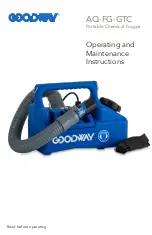
BPS – K – 3.0 – 6.0
Sherpa
Autodiagnostik
page: 19
- Follow the operating instructions.
6.6
Option lifting/lowering device
SVZ 210085 - Pneumatically operated lifting/lowering device; if it is employed as a step protection, a
vehicle with a maximum axle load of 4 t is allowed to drive over it.
- the lifting/lowering device is automatically lifted or lowered due to weight recognition
SVZ 210085 - The pneumatically operated lifting/lowering device has a lifting force of up to 2.2 t,
- It can carry a load of 4 t when the vehicle is driven over the test stand; manual lifting
and lowering operation is carried out by means of the automatic button at the control
box (or by means of the option "remote control radio").
6.6.1
Description / Installation
- The lifting/lowering device is a completely separate component which needs to be attached to the
set of rolls. If older test units are upgraded, 4 holes need to be drilled beneath the set of rolls on
each side in order to screw the lifting/lowering device to it.
- The lifting/lowering device is equipped with an air ram which lifts and lowers the device. In the
middle of the roller set a pneumatic valve which controls the air rams is installed. The pneumatic
valve is controlled by the PC board of the control box.
- The air supply line is connected to the pneumatic valve. Its supply pressure needs to be between
6 and 9 bar but if it is higher, a pressure limiter needs to be installed.
6.6.2
Application
- The V-shaped slot between the rollers is covered by the "lifting/lowering device" in standby mode.
This provides us with a safety device which prevents people who walk around this area from
tripping over the brake rollers.
- If a vehicle is driven over a
standard test stand
, its wheels will rest in the V-shaped slot between
the rollers and consequently cause a noise which is perceived as unpleasant by some users. If
the lifting/lowering device is elevated, a vehicle of about 4 t can be driven over the V-slot cover
without its wheels sinking in between the roller set completely. By this means, the vehicle can be
driven over the test stand without causing any noise.
- Vehicles with a low ground clearance and spoilers are gently lowered into the V-shaped slot by
means of the lifting/lowering device. This prevents spoilers and low vehicle components from
being damaged.
6.6.3
Description
-
If the lifting/lowering device is used as a step protection,
it is not responsible for lifting the
vehicle's wheels out of the gap between the rollers. This would significantly extend the time in
which the vehicle is being tested and require a manual operation via an actuating switch or a
remote control.
- The vehicle can easily be driven out of the set of rollers, as we have installed a standard auxiliary
drive-off system which prevents the rollers from over-speeding at all times and hence facilitates
driving out of the test stand. The set of rollers is equipped with a weight sensor and can identify
the axle weight of the vehicle after an adjustable time delay and the weight has been set and
automatically lifts or lowers the
"lifting/lowering device"
. Therefore, any manual operation
becomes unnecessary.
-
The lifting/lowering device can lift
the wheels out of the V-shaped slot between the rollers with
a lifting force of 2.2 t axle weight. It is manually operated by means of the radio remote control
"Radio"
- The lifting/lowering device is operated pneumatically with a maximum pressure of 6-9 bar and is
controlled electronically. The standard time needed to lower the wheels is about 3 seconds and
can be customized by means of a throttling valve (optional).
- Please Note: If the test unit is turned off and compressed air is still in the system, the lifting
device remains elevated.
- If the air pressure is less than 2 bar, the outlet valve will not open anymore. If necessary, the air
supply line needs to be disconnected from the pressure switch/ automatic button.
















































